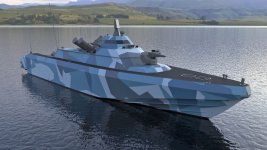T
Turko
Guest
You mean like narco-submarinesCould be faster and less fuel consumption but no good in choppy seas. Breaks down easily! (At least the Russian ones we had did) .
Also the higher off the sea , the easier to see on radar!
You should try to go the other direction. If we could sink it as much as we could it would be better. Ideally next stage could be a completely submerged version with only a small RAM painted snorkel above water to communicate with and coming out of water when in range.






